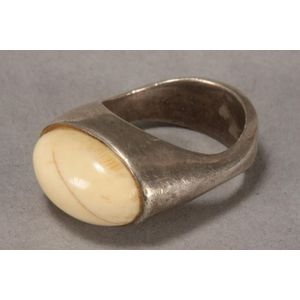Modernist Ivory and Silver Ring
sterling silver and ivory ring, the band of modernist styling, set with convex oval shaped ivory, size N
You must be a subscriber, and be logged in to view price and dealer details.
Subscribe Now to view actual auction price for this item
When you subscribe, you have the option of setting the currency in which to display prices to $Au, $US, $NZ or Stg.
This item has been sold, and the description, image and price are for reference purposes only.
- Sterling Silver - Sterling silver is a mixture of 92.5% pure silver and 7.5% of another metal, usually copper. Fine silver is 99.9% pure silver, and is relatively soft and the addition of the very small amount of copper gives the metal enough strength and hardness to be worked into jewellery, decorative and household objects.
- Modernism / Modernist - Modernist furniture and design emerged in the early to mid-20th century as a response to traditional styles of the 19th century and prior times, and a reflection of the technological and social changes of the time. Characteristics of Modernist furniture and design include simplicity and minimalism and clean lines and a lack of unnecessary ornamentation are key features. That form follows function is a fundamental principle of Modernist design, and furniture and objects are designed with a focus on their practical use.
Modernist furniture often incorporates geometric shapes, such as cubes, rectangles, and circles. This reflects a departure from the more ornate and curvilinear forms of previous design styles. The furniture often prioritizes ergonomic design, ensuring that objects are comfortable and user-friendly. Modernist designers aimed to create designs that could be mass-produced, making good design accessible to a broader population.
Prominent figures associated with Modernist furniture and object design include designers such as Hans Wegner, Verner Panton, Florence Knoll, Harry Bertoia and Ettore Sottsass - Ivory - Ivory is a hard white material that comes from the tusks of elephants, mammoth, walrus and boar, or from the teeth of hippopotamus and whales. The ivory from the African elephant is the most prized source of ivory. Although the mammoth is extinct, tusks are still being unearthed in Russia and offered for sale.
Ivory has been used since the earliest times as a material for sculpture of small items, both in Europe and the east, principally China and Japan.
In Asia ivory has been carved for netsuke, seals, okimono, card cases, fan supports, animals and other figures and even as carved tusks.
In the last 200 years in Europe ivory has been used to carve figures, for elaborate tankards, snuff boxes, cane handles, embroidery and sewing accessories, in jewellery and as inlay on furniture. Its more practical uses include being used for billiard balls, buttons, and a veneers on the top of piano keys.
The use and trade of elephant ivory have become controversial because they have contributed to Due to the decline in elephant populations because of the trade in ivory, the Asian elephant was placed on Appendix One of the Convention on International Trade in Endangered Species (CITES), in 1975, and in January 1990, the African elephant was similarly listed. Under Appendix One, international trade in Asian or African elephant ivory between member countries is forbidden. Unlike trade in elephant tusks, trade in mammoth tusks is legal.
Since the invention of plastics, there have been many attempts to create an artificial ivory
This item has been included into following indexes:
-
rings, material
- ivory 26
- silver items 2,400
